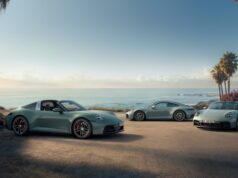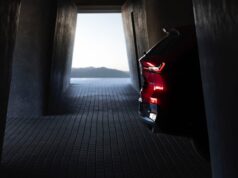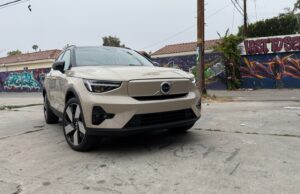
The 2012 Mazda3 is getting a nice bump in fuel efficiency thanks to Mazda’s new SkyActiv-G engine and SkyActiv transmissions.
The current Mazda3 only manages to get up to 33 mpg with its non-direct injected 2.0L, but thanks to the new engine the Mazda3 now gets up to 40 mpg. The direct-injection SkyActiv-G 2.0-liter engine puts out 155 horsepower and 148 lb-ft. of torque. The engine can be mated to either a six-speed manual or six-speed automatic SkyActiv transmission. The SkyActiv engine is available on either the sedan or five-door, but the current 2.0L will still be around, but only on the sedan. The MZR 2.5-liter engine is also still available.
The Mazda3 can now take on the new competition from the Focus, Cruze and Elantra. Mazda has also given the 2012 Mazda3 a slight refresh inside and out. The restyled front fascia tones down the smiling grin that everyone hated on the current Mazda3.
PRESS RELEASE:
2012 MAZDA3 WITH SKYACTIV MAKES U.S. DEBUT, BOASTS 40 MPG ON THE HIGHWAY
– Refreshed 2012 Mazda3 Equipped With SKYACTIV-G, SKYACTIV-Drive
to Achieve Highest MPG of Any Mazda –
NEW YORK (April 21, 2011) – The 2012 Mazda3 made its U.S. debut today at the New York International Auto Show. Face-lifted with an even more refined exterior and interior, the 2012 Mazda3 also is the first application in North America of Mazda’s innovative SKYACTIV fuel-saving and performance-oriented technologies, achieving 40 mpg on the highway. The Mazda3 model is Mazda’s best-selling vehicle worldwide and accounts for nearly half of all Mazda sales in the United States, making the vehicle a prime candidate for introducing SKYACTIV to consumers looking for dynamic performance coupled with high fuel efficiency.
“SKYACTIV is not just an engine; it is the next generation of advanced vehicle performance and efficiency,” said Jim O’Sullivan, President and CEO, Mazda North American Operations (MNAO). “SKYACTIV embodies Mazda’s philosophy of engineering only vehicles that are fun to drive, satisfying to own and environmentally responsible; and there is no better vehicle to start with than the Mazda3, one of the most exciting sport compact cars on the road.”
Redesigned for the 2010 model year, the refreshed 2012 Mazda3 is Mazda’s first application of SKYACTIV technologies in North America, receiving an all-new SKYACTIV-G gasoline engine as well as the all-new SKYACTIV-Drive six-speed automatic transmission and all-new SKYACTIV-MT six-speed manual transmission. It also features improved sporty driving dynamics, responsive handling and a comfortable cabin space. The exterior design also has been refined to express a bolder stance, alongside new interior appointments creating additional functionality without sacrificing the touch-and-feel quality. Additional safety features complete the package.
Mazda3, SKYACTIV Reach New Heights
In addition to the Mazda3’s current MZR 2.0-liter dual-overhead-cam 16-valve four-cylinder engine is the all-new high-efficiency direct-injection SKYACTIV-G 2.0-liter gasoline engine. Mated to a standard SKYACTIV-MT six-speed manual transmission or optional SKYACTIV-Drive six-speed automatic transmission, SKYACTIV will be available in either the sedan or hatchback models. The MZR 2.0-liter engine will continue to be available with the current five-speed manual as standard equipment. MZR 2.0-liter-equipped models also will be available with the current five-speed automatic as an option.
Approximately 4.4 pounds lighter than the current MZR 2.0-liter engine, the SKYACTIV 2.0-liter adopts multi-hole injectors to enhance fuel spray characteristics, along with specially developed piston cavity shapes that ensure a shorter combustion time and suppresses the impact on power and torque from engine knocking. Pumping loss is also decreased by employing dual sequential valve timing (S-VT).
The 2012 Mazda3 achieves a high compression ratio of 12.0:1 and delivers 155 horsepower at 6,000 rpm and 148 lb-ft of torque at 4,100 rpm. (The PZEV version of this engine sold in California and other states produces 154 hp at 6,000 rpm and 148 lb-ft of torque at 4,100 rpm).
Compared to the current Mazda3 MZR 2.0-liter engine, the maximum power of the SKYACTIV-equipped 2012 Mazda3 is increased by approximately five percent (from 148 horsepower at 6,500 rpm) and torque is increased by approximately 10 percent (from 135 lb-ft at 4,500 rpm). With improved torque, coupled with a drive control system that utilizes coordinated controls of the engine and transmission, Mazda3s with SKYACTIV technology excel in dynamic response, further maintaining the Zoom-Zoom idea of oneness between the car and driver.
Fuel economy also gets a boost from the combination of a SKYACTIV engine and transmissions. When equipped with the SKYACTIV-G gasoline engine and optional SKYACTIV-Drive six-speed automatic transmission, the 2012 Mazda3 sedan will achieve an EPA rating of 40 mpg on the highway, an approximately 21-percent improvement over the current MZR 2.0-liter engine equipped with the optional five-speed automatic transmission. With a fuel tank capacity of 14.5 gallons, the 2012 Mazda3 sedan with SKYACTIV has the potential of a 540-mile range, with still a gallon of fuel remaining. City mpg for the sedan version also improves by 17 percent to 28 mpg. When equipped with the SKYACTIV-MT six-speed manual transmission, the sedan is rated with an estimated fuel economy of 27 city/39 highway.
The Mazda3 sedan with the MZR 2.0-liter has an EPA fuel economy rating of 25 city/33 highway with the standard five-speed manual transmission and 24 city/33 highway with the optional five-speed automatic transmission.
Also, previously only available with the MZR 2.5-liter engine, the Mazda3 five-door hatchback model will now be offered in the U.S. with the SKYACTIV-G 2.0-liter gasoline engine. This Mazda3 hatchback is estimated to deliver 27 city/38 highway (SKYACTIV-MT) and 28 city/38 highway (SKYACTIV-Drive AT). The slightly lower highway estimates can be attributed to different aerodynamics and the higher weight ratio between the sedan and hatchback. However, the hatchback’s driving range remains impressive with more than 500 miles of driving on the same sized tank as the sedan. The MZR 2.0-liter engine will not be available in the hatchback model.
The higher fuel economy of the 2012 Mazda3 equipped with SKYACTIV is a direct result of combining all the best features of the technology in today’s transmissions. For SKYACTIV-Drive, the key advantages of a conventional automatic transmission, Continuously Variable Transmission (CVT) and Dual Clutch Transmission (DCT) were integrated. In addition, a torque converter with a lock-up clutch was developed to ensure minimal decrease in fuel economy and an increase in direct drive feel.
For SKYACTIV-MT, the goal was to achieve a shift feel that is sporty, brisk and responds to the driver. To accomplish this, not only was the shift-lever stroke shortened by about 10 percent compared to the current six-speed manual (available only in models equipped with the MZR 2.5-liter engine or MZR 2.3-liter Direct-Injection Spark Ignition turbo engine) but other technologies were applied as well: a down type system, lock ball type synchronizer, shift load canceller, slide ball bearing and locating 2nd and 3rd gears on a common shaft. By reconfiguring the current six-speed manual transmission, its weight was reduced by approximately 4.4 pounds due to the need for fewer components, while creating a quicker and crisper shift feel. Call it a little “MX-5 Miata-ness” in the Mazda3.
Also available on the 2012 Mazda3 is the highly-acclaimed Mazda MZR 2.5-liter engine. Alongside the SKYACTIV-G 2.0-liter, the MZR 2.5 is a technology powerhouse as well. It offers an aluminum block with cylinder-bore liners made of a steel-molybdenum alloy offering strength and stiffness generally not seen in large-displacement four-cylinder engines. A forged-steel crankshaft provides strength at high revs, but rigidity to ensure low NVH characteristics. Additionally, twin balance shafts located in the oil sump cancel second-order noise and vibration. The deep-skirt block is engineered for extra stiffness and main-bearing caps are integral with a ladder-type lower-block reinforcement. To minimize the noise and vibration typically found on larger displacement four-cylinder engines, the damper at the forward end of the crankshaft is equipped with two tuned masses. At the output end, a flexible flywheel also curbs NVH.
Fuel is delivered to the intake ports by an electronically controlled sequential injection system. Ignition coils are modular units positioned directly above the spark plugs. Shim-less bucket tappets require no maintenance. Lightweight pistons are coated with a special anti-friction compound and fitted with low-tension rings for improved gas mileage. Sintered powder-metal connecting rods and lighter full-floating wrist pins minimize the reciprocating weight.
Providing 167 hp at 6,000 rpm and 168 lb-ft of torque at 4,000 rpm, the MZR 2.5-liter engine is available with a six-speed manual transmission or a five-speed electronically-controlled automatic with manual shift control. (The PZEV version of this engine sold in California and other states produces 165 hp at 6,000 rpm and 167 lb-ft of torque at 4,000 rpm). The MZR 2.5-liter engine achieves EPA figures of 20 city and 28 highway with a manual transmission and 22 city and 29 highway with the automatic.
Distinctively Dynamic
The Mazda3 has earned a solid reputation for its sporty and exciting handling that delivers an equally pleasurable driving feel which emphasizes consistency between the driver’s expectations and the car’s response. Inheriting this pedigree, the refreshed 2012 Mazda3 not only improves upon this sense of oneness between driver and vehicle, but also offers a comfortable driving experience that all passengers can feel and enjoy in various driving scenarios.
Referred to as Toitsukan, this linear and consistent feel is more specifically about establishing smooth transitions between acceleration, lateral and deceleration G forces in response to the basic aspects of driving, turning and stopping. This idea is not simply about delivering sharp response to accelerator and steering operations for a sporty ride, but instead delivering a consistent linear feeling of the car’s every response to control operations of the driver. Toitsukan extends to making driving pleasurable and instilling drivers with the sensation of excitement and control while at the same time offering passengers a comfortable ride created by smooth and stable car movement.
Concentrated efforts were made to ensure this Toitsukan is achieved throughout the car’s features, which also resulted in a stronger body, include the adoption of the Electro-Hydraulic Power Assist Steering (EHPAS) system and optimized tuning of the front and rear dampers. Mazda’s EHPAS system employs a new setting for pump flow characteristics that enables easier handling at slow speeds while also achieving more positive feedback and a better feeling for the road at mid-range through to high speeds. The overall result when compared to the current model is lighter, more nimble steering feel.
Put simply: turn the wheel a little, get a little change of direction; turn the wheel a lot, get a lot of change of direction. It seems so easy, but so few manufacturers seem to be able to achieve this level of intuition.
The body of the 2012 Mazda3 also has been further reinforced for greater rigidity, improving upon the current model’s already stellar agility and handling stability. This was partly achieved by increasing the number of spot welds used to join the suspension crossmembers (to which the front and rear suspensions are mounted) to the reinforced body areas. Use of stronger materials for reinforcements made it possible to more effectively disperse input from the suspension crossmember mounts to the body, thereby greatly improving overall body rigidity. In addition, the two reinforcement bars located under the center of the floor panel of the current Mazda3 were replaced by a single new brace that is both stronger and more rigid. Employing this sheet of reinforcing material suppresses fore-aft body deformation. This update applies only to models equipped with the SKYACTIV-G 2.0-liter or MZR 2.5-liter engines.
Additionally, models powered by SKYACTIV-G 2.0-liter gasoline engines are equipped with a drive control system that controls torque generation to maintain a harmonious balance between engine output and the gears of the transmission. Programmed in such a way to determine how much acceleration is called for in relation to the amount of acceleration pedal action, the system ensures the right amount of torque generated matches the acceleration demands. This instills in the driver a sense of confidence that the vehicle will respond faithfully and predictably. A driver’s desired speed can be reached without the need of a heavy foot on the accelerator, thus contributing to less waste of fuel.
Engaging, Efficient Exterior
This mid-generation evolution of the Mazda3 also extends to its exterior design. The current model’s rich expression and bold stance has been updated to deliver a well-toned look that conveys even higher quality and curb appeal. Increased aerodynamics and stylized features give the 2012 Mazda3 a more sophisticated look, blending seamlessly with functionality.
The 2012 Mazda3’s exterior appearance ultimately features a more taut impression with a new front fascia and updated five-point grille opening for both sedan and hatchback styles. New design characteristics include more delicately sculpted forms around the openings on the outside edge of the front bumper and a rounded fog lamp shape (changed from the horizontally-wide version of the current model).
Mazda3 sedan and hatchback models equipped with SKYACTIV-G gasoline engines will be further distinguished with exclusive elements, such as an all-new engine cover featuring a deep blue metallic paint finish with black sections along either side; headlamp units outfitted with a transparent blue ring around the center lens to emphasize the vehicle’s distinctive character; and a badge featuring a “SKYACTIV” logo against a clear-blue background.












